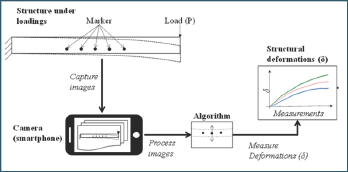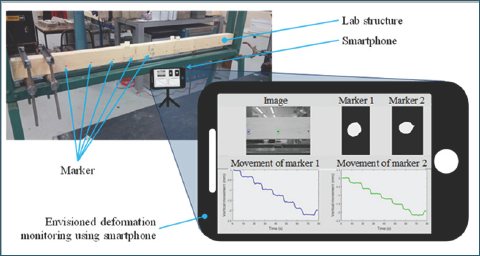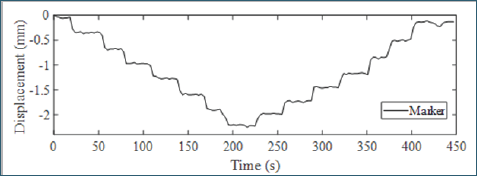
Lupine Publishers Group
Lupine Publishers
Menu
ISSN: 2637-4668
Opinion(ISSN: 2637-4668) 
Estimating Deformations of Laboratory Structures Subjected to Loadings Using Images Collected with Phone Camerase Volume 1 - Issue 3
Rolands Kromanis*- Nottingham Trent University, UK
Received: January 30, 2018; Published: February 09, 2018
*Corresponding author: Rolands Kromanis, Maudslay Building, Room 312, School of Architecture, Design and the Built Environment, Nottingham Trent University, 50 Shakespeare St, Nottingham NG14FQ, UK
Introduction
A Fundamental civil engineering knowledge is the ability to understand, explain and calculate deformations of/in civil structures. New civil engineers acquire this knowledge at universities in material science, engineering mechanics and introduction to structural engineering modules. Structural deformations can be calculated when knowing material properties, geometry and boundary conditions of a structure and loads that are applied on/to it. Inverse engineering can be employed if deformations of a structure are known, but some other parameters are not known. Theoretical formulae are then tested using laboratory test beds, usually beams. Laboratory technicians are responsible for the acquisition of deformation measurements of laboratory tests. Their time is often limited and so is the number of available measurement collection devices such as dial gauges and strain gauges. If devices that do not log measured deformations are employed, information of structural deformations or response might be lost or readings might not be collected at required intervals. However, all laboratories do not offer luxury of sensors that are available at hand and technicians, which would have time to install sensorsand collect data when needed, especially if this as to be done with a short period of notice. This paper introduces a low-cost vision-based system for deformation estimations of laboratory structures.
Significant research is done in the image processing and photogrammetry fields, which is reviewed in recently published paper [1]. Ho et al. [2] demonstrated that two camcorders when used simultaneously can capture displacements of civil structures. Ye at el. [3] employed high-resolution industrial digital cameras with extended-range zoom lenses to collect dynamic movements of long- span bridges and derived structural displacements from collected images. In above examples, camcorders or high-resolution cameras were employed. This study shows that mobile phone cameras can be used to do the above. DefoMonit- software introduced in this paper and developed at Nottingham Trent University (NTU) [4], can analyse consecutively collected images of structures subjected to loadings and estimate structural deformations. DefoMonit, in contrast to proprietary software, is free for students and academics. The next sections provide general introduction to the vision-based system and a laboratory case study.
Methodology
Figure 1: A schematic representation of condition assessment of a structure under loadings using a low cost vision-based measurement collection system with a smart phone camera.

Figure 1 presents a proposed system for estimating deformations such as deflections in laboratory test-beds. A selected test-bed is a cantilever beam subjected to loadings. Markers or points of interest are drawn on the surface of the beam. Images are captured with a phone camera while the load is applied to the beam. When analysing collected images with DeforMonit, the location of the markers is tracked, and structural deformations are estimated.
A laboratory structure subjected to loadings
Figure 2: Envisioned set-up of the vision-based system using a phone to collect and DeforMonit to analyse images for deformation estimation of a cantilever at the lab in (NTU).a.

An illustration of the proposed system using a phone for deformation monitoring of a cantilever beam is shown (see Figure 2). Markers are drawn on the face of the beam. A phone is placed at a preferred distance from the laboratory structure. Setting the correct distance, at which images are taken, has a direct impact on the resolution of images and calculated structural deformations. Understanding of structures is required to provisionally estimate expected movement of the laboratory structure. The collected images are analysed using DeforMonit, and time series of estimated deformations are generated.
Figure 3: Time series of vertical movements of a selected marker on the timber beam.

Consider the timber cantilever shown in Figure 2. The cantilever is 900mm long, 45mm wide and 70mm deep. A load is applied manually at its right end using 5N load step. When the applied load reaches 35N, it is removed using 5N steps. Samsung A3 phone is deployed to capture images of the cantilever under loadings. The phone is placed 800mm away from the cantilever capturing its entire length. The movement of a marker at its far right end is tracked and plotted in Figure 3.
Summary and Conclusion
This synopsis introduces DefoMonit, a freeware for image analyses of structures subjected to loadings for accurate estimations of structural deformations. The accuracy of estimated deformations using DeforMonit is validated on laboratory and full-scale structures [4]. Students at NTU use DeforMonit in their final year project. In this paper, an example showing deformations of a cantilever beam subjected to manually applied loads is demonstrated in Figure 3.
References
- Xu Y, Brownjohn JMW (2017) Review of machine-vision based methodologies for displacement measurement in civil structures. Journal of Civil Structural Health Monitoring 8(1): pp. 91–110.
- Hoai-Nam Ho, Jong-Han Lee, Young-Soo Park, and Jong-Jae Lee (2012) A synchronized multipoint vision-based system for displacement measurement of civil infrastructures. The Scientific World Journal 2012(2012): p. 9.
- Ye XW, Ni YQ, Wai TT, Wong KY, Zhang XM, et al. (2013) A vision-based system for dynamic displacement measurement of long-span bridges: algorithm and verification. Smart Structures and Systems 12(3-4): 363379.
- Kromanis R, Al-Habaibeh A (2017) Low cost vision-based systems using smartphones for measuring deformation in structures for condition monitoring and asset management. In the 8th International conference on Structural Health Monitoring of Intelligent Infrastructure. Brisbane, Australia.

Top Editors
-

Mark E Smith
Bio chemistry
University of Texas Medical Branch, USA -

Lawrence A Presley
Department of Criminal Justice
Liberty University, USA -

Thomas W Miller
Department of Psychiatry
University of Kentucky, USA -

Gjumrakch Aliev
Department of Medicine
Gally International Biomedical Research & Consulting LLC, USA -

Christopher Bryant
Department of Urbanisation and Agricultural
Montreal university, USA -

Robert William Frare
Oral & Maxillofacial Pathology
New York University, USA -

Rudolph Modesto Navari
Gastroenterology and Hepatology
University of Alabama, UK -

Andrew Hague
Department of Medicine
Universities of Bradford, UK -

George Gregory Buttigieg
Maltese College of Obstetrics and Gynaecology, Europe -

Chen-Hsiung Yeh
Oncology
Circulogene Theranostics, England -
.png)
Emilio Bucio-Carrillo
Radiation Chemistry
National University of Mexico, USA -
.jpg)
Casey J Grenier
Analytical Chemistry
Wentworth Institute of Technology, USA -
Hany Atalah
Minimally Invasive Surgery
Mercer University school of Medicine, USA -

Abu-Hussein Muhamad
Pediatric Dentistry
University of Athens , Greece

The annual scholar awards from Lupine Publishers honor a selected number Read More...










